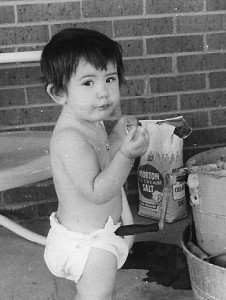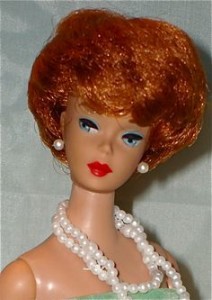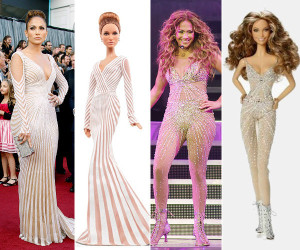By now, you have heard that Mattel has tried to diversify its long-time bestselling doll, Barbie, in response to criticism her impossible proportions negatively affect young girls’ body images.
If you read my blog at all, you know I have linked the plastic doll to the super thin plastic “ideal” body seen in every Hollywood film, on the fashion runways, and in advertising.
Almost sixty years ago, Barbie was modeled literally from the original dollmaker’s 12-year-old son’s body – wide shoulders, narrow hips, otherworldly long legs and neck – and then a pair of large fake breasts were appended.
Mattel didn’t cave in and change Barbie because of the collateral damage to females. Instead, they changed the 57-year-old doll due to lowered sales in a world where women have effectively (finally!) rejected the anorexic ideal in favor of reflecting realistic shapes and sizes of females.
It can’t be argued many women have measured themselves against this superthin image, with disastrous results like food addiction, anorexia, disordered eating, bulimia. A recent study published in Psychology Today showed 91% of women were dissatisfied with their bodies, with almost 80% saying they were too heavy, when only about 60% of all women are overweight.

The focus on thin in media has been changing. Who cares if Angelina Jolie can subsist on 600 calories a day? No one is watching her movies, because they are seriously awful, which is why she has to do such outrageous things to get publicity these days.
The public is much more engaged with Amy Schumer, who is seriously funny, and hasn’t abandoned her body to Hollywood’s makeover artists. And with Kim Kardashian’s curvy derriere. And they are fascinated with the sexy new Sports Illustrated swimsuit model Ashley Graham. (Photo by James Macari/from the Sports Illustrated Swimsuit Issue on sale now.)
When moms started taking their hard women-earned dollars to toys with less negative impact, Mattel made changes to Barbie, beyond adding their traditional new career outfit to her wardrobe. (I’m wondering if sales on that Susie Homemaker Magic Oven and the pink vacuum are plummeting too.)
And I really wanted to say “Yeah! Finally! Good job!” to Mattel.
But, here’s the deal:
First, Mattel is keeping the traditional Barbie, who, if human, would be 5’9″ tall, 110 lbs, and could not stand upright on her tiny feet. (She could crawl on hands and knees but her knees don’t bend!)
Second, they have added three new “body types”: tall, petite and curvy. As if that might soften the choice.
Third, they’ve also added new hair and skin colors. As if that actually matters – 3 out of 5 Barbies sold are blonde.
Isn’t that just what we’re looking for, when 85% of young girls own at least one Barbie?
More labels!
New categories!
Another set of boxes in which to fit!
Are you an inhumanly proportioned alien, curvy, petite or tall?
Is it so hard to just make dolls that reflect real life? When you’re making a JLo (Jennifer Lopez) “Barbie” – why not just represent her real proportions?
JLo is beautiful! In her actual size! At any size!
Defending itself against the claim it has negatively impacted little girls’ body images, Mattel has blamed moms instead (Time Magazine, Feb. 8, 2016), although many studies, including 2006 research published in Developmental Psychology have indicated girls exposed to Barbie, at an early age, are more concerned with being thin and diet earlier in life.
Today, 80% of ten year-old girls have been on a diet and over half of 5-year-olds say they’d like to be thinner.
Dieting is the #1 cause of excess weight. All those little girls grow up to diet more/regain more and ultimately create more obesity.
This isn’t harmless! What we say and how we represent the female body IS affecting kids. When they are young, they have no defenses against the images they see. Their view of the world is limited, and often confined to media.
This really hit home for me as I wrote this blog.
If I had even one person tell me Barbie and her real-life anorexic shadows in film, tv, fashion and media were unrealistic – and my size and shape were healthy – while I was in high school, I could have conquered the world with the energy I spent dieting, regaining and fighting off the subsequent health issues associated with my excess weight.
I lived through and healed a serious food addiction. One of the challenges I had to conquer was a perfectionist tendency. Many times – waaaayyy too many times – I lost weight and, when I didn’t look like a movie star (where were you Mindy Kahling, America Ferrera, and Rebel Wilson when I needed positive role models?), I simply regained it all.
I had to accept the limits of my physical body and learn to love it, so I could take good care of myself.
It wasn’t easy.
So, you could say I faced my Barbie and overcame her.
Or did I?
As a kid, I was often taunted and ridiculed because people couldn’t categorize me racially. My father was American Indian, my mother was Caucasian. I had black hair and tiny slanted eyes. I lived in Texas and my town was solidly divided into three groups – black, white and Hispanic – members of every group called me a “chink”, a “jap” and a “halfbreed.”
 Decades later, I became a decided redhead.
Decades later, I became a decided redhead.
And I do love being a redhead. As I changed, and healed my addiction, I opened up to life and life got fun. I felt my hair color reflected my personality.
So, for quite some time I’ve been a redhead.
And never gave it much thought, until I started to write this blog and googled for an image of my first Barbie.
And, here she is.
Damn if that didn’t hit me deep!
Maybe I haven’t conquered my Barbie. Maybe she’s still in there.
Maybe those early images are even more powerful than we think, lodging deep into our unconscious mind.
If they can hide from the thorough and introspective healing work I’ve done, imagine what they do in the minds of the young, the unaware, the innocent.







